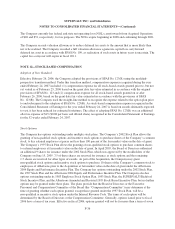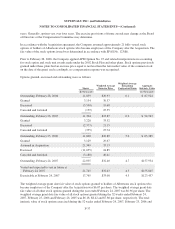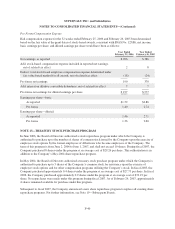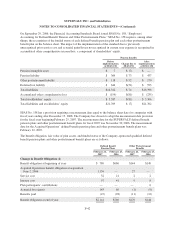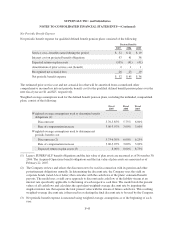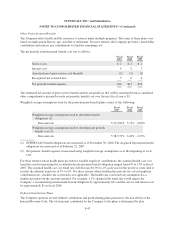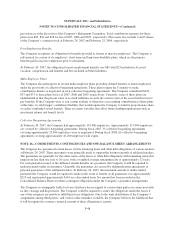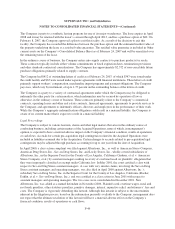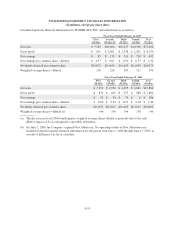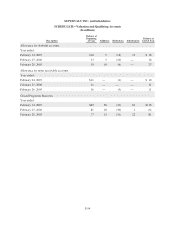Albertsons 2007 Annual Report Download - page 112
Download and view the complete annual report
Please find page 112 of the 2007 Albertsons annual report below. You can navigate through the pages in the report by either clicking on the pages listed below, or by using the keyword search tool below to find specific information within the annual report.
SU
PERVAL
U
IN
C
. and
S
ubsidiaries
N
OTES TO CONSOLIDATED FINANCIAL STATEMENTS—(Continued)
(
4) Expected lon
g
-term return on plan assets is estimated b
y
asset class and is
g
enerall
y
based on widel
y-
a
ccepted capital market principles, long-term return analysis for global fixed income and equity markets, the
a
ct
i
ve tota
l
return-or
i
ente
d
port
f
o
li
o management sty
l
easwe
ll
as t
h
e
di
vers
ifi
cat
i
on nee
d
san
d
re
b
a
l
anc
i
ng
c
haracteristics of the plan. Lon
g
-term trends are evaluated relative to market factors such as inflation,
i
nterest rates and fiscal and monetary polices in order to assess the capital market assumptions
.
C
ontributions
T
he Compan
y
expects to contribute $32 to its pension plans and $13 to its postretirement benefit plans in fisca
l
2
008. T
h
e Company’s
f
un
di
ng po
li
cy
f
or t
h
e
d
e
fi
ne
db
ene
fi
t pens
i
on p
l
ans
i
s to contr
ib
ute t
h
em
i
n
i
mum
contr
ib
ut
i
on a
ll
owe
d
un
d
er t
h
e Emp
l
o
y
ee Ret
i
rement Income Secur
i
t
y
Act (“ERISA”), w
i
t
h
cons
id
erat
i
on
gi
ven
to contributin
g
lar
g
er amounts in order to be exempt from Pension Benefit Guarant
y
Corporation (“PBGC”
)
v
ar
i
a
bl
e rate prem
i
ums or part
i
c
i
pant not
i
ces o
f
un
d
er-
f
un
di
ng. T
h
e Company w
ill
recogn
i
ze contr
ib
ut
i
ons
i
n
a
ccor
d
ance w
i
t
h
app
li
ca
bl
ere
g
u
l
at
i
ons, w
i
t
h
cons
id
erat
i
on
gi
ven to reco
g
n
i
t
i
on
f
or t
h
e ear
li
est p
l
an
y
ear
p
ermitted.
Pl
an A
ss
et
s
Plan assets are held in trust and invested in separatel
y
mana
g
ed accounts and publicl
y
traded mutual funds
h
oldin
g
equit
y
, fixed income securities and alternative investment classes.
T
he Compan
y
emplo
y
s a total return approach whereb
y
a mix of equities and fixed income investments are use
d
to max
i
m
i
ze t
h
e
l
ong-term return o
f
p
l
an assets
f
or a pru
d
ent
l
eve
l
o
f
r
i
s
k
.A
l
ternat
i
ve
i
nvestments,
i
nc
l
u
di
n
g
h
e
dg
e
f
un
d
s, pr
i
vate equ
i
t
y
an
d
rea
l
estate are a
l
so use
dj
u
di
c
i
ous
ly
to en
h
ance r
i
s
k
a
dj
uste
dl
on
g
-term returns
w
hile improvin
g
portfolio diversification. The overall investment strate
gy
and polic
y
have been developed based
o
nt
h
e nee
d
to sat
i
s
f
yt
h
e
l
ong-term
li
a
bili
t
i
es o
f
t
h
e Company’s pens
i
on p
l
ans. R
i
s
k
management
i
s
a
ccomp
li
s
h
e
d
t
h
rou
gh di
vers
ifi
cat
i
on across asset c
l
asses, mu
l
t
i
p
l
e
i
nvestment mana
g
er port
f
o
li
os an
db
ot
h
g
eneral and portfolio-specific investment
g
uidelines. Risk tolerance is established throu
g
h careful consideration
of
t
h
ep
l
an
li
a
bili
t
i
es, p
l
an
f
un
d
e
d
status an
d
t
h
e Company’s
fi
nanc
i
a
l
con
di
t
i
on. T
hi
s asset a
ll
ocat
i
on po
li
cy m
i
x
i
s rev
i
ewe
d
annua
lly
an
d
actua
l
a
ll
ocat
i
ons are re
b
a
l
ance
d
on a re
g
u
l
ar
b
as
i
s
.
P
l
an assets are
i
nveste
d
us
i
ng a com
bi
nat
i
on o
f
act
i
ve an
d
pass
i
ve
i
nvestment strateg
i
es. Pass
i
ve strateg
i
es
i
nvest
in broad sectors of the market primaril
y
throu
g
h the use of indexin
g
. Indexin
g
is an investment mana
g
ement
a
pproach based on investing in exactly the same securities, in the same proportions, as an index, such as the S&
P
500. Active strategies employ multiple investment management firms. Managers within each asset class cover a
ran
g
e of investment st
y
les and approaches and are combined in a wa
y
that controls for capitalization, and st
y
le
b
iases (equities) and interest rate bets (fixed income) versus benchmark indices while focusing primarily o
n
secur
i
ty se
l
ect
i
on as a means to a
dd
va
l
ue. Mon
i
tor
i
ng act
i
v
i
t
i
es to eva
l
uate per
f
ormance aga
i
nst targets an
d
measure investment risk take place on an on
g
oin
g
basis throu
g
h annual liabilit
y
measurements, periodic asset/
l
iability studies and quarterly investment portfolio reviews
.
T
he asset allocation
g
uidelines and the actual allocation of pension plan assets are as follows:
Asset Category
Target Allocation
R
anges
Pl
a
nA
sse
t
s
Fiscal 200
7
Pl
a
nA
sse
t
s
Fiscal 2006
D
omestic Equit
y
45.0% - 70.0% 52.5% 60.1
%
International Equit
y
7.0% - 20.0% 17.7% 9.9
%
D
omestic Fixed Income 2
5
.0%-3
5
.0% 29.
5
% 24.
5%
C
ash and
O
ther
0
.
0
%-1
5
.
0
%
0
.
3
%
5
.
5%
T
otal 100.0% 100.0
%
F-4
6


